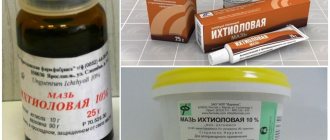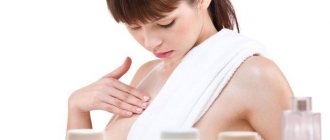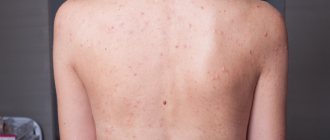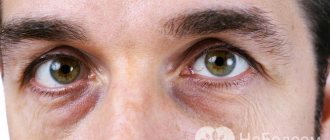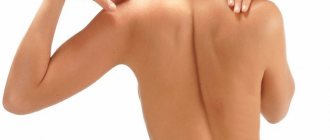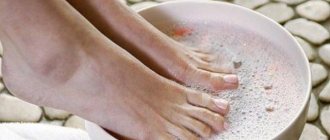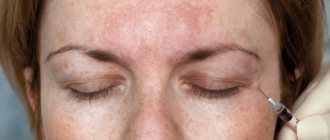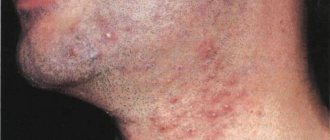Acne (blackheads, acne) is a chronic disease of the sebaceous glands and hair follicles. It is characterized by clogged glands and increased production of sebum, which makes the skin elastic and protects against infections. This disease affects most young people. But sometimes there is acne on the face of an adult, the treatment of which is somewhat different from the treatment of teenage acne. If a person is 30-40 years old or older and suffers from acne, then this is probably a symptom of some other disease, and he should consult a dermatologist.
Symptoms
Acne can appear in any area of the face:
- a rash around the mouth indicates problems with the gastrointestinal tract;
- in the area of the cheeks and cheekbones – problems with the gallbladder;
- acne on the chin - a woman has a gynecological problem;
- A rash near the ears indicates a weak immune system.
Stages
Treatment of acne depends on the stage of the disease.
There are 3 degrees of acne severity:
Lightweight
Closed and open acne are scattered over the skin of the face without signs of inflammation and there are less than 10 acne elements on the face.
Average
10-40 acne elements.
Heavy
There are more than 40
on the skin of the face , which are usually inflamed and contain purulent contents.
Fighting the disease
How to deal with acne, how to treat. Acne can go away on its own without medical intervention. But it’s better not to hope for this, not to waste time in vain (which is why the disease can only progress), and immediately if any rashes appear on the skin, go to a dermatologist. Modern medicine is well armed against this problem. She has at her disposal lotions, tablets, gels, ointments, creams containing active ingredients that:
- do not allow comedones to develop;
- destroy the formed pustules;
- control the formation of sebum;
- relieve inflammation.
Causes of the rash
Acne occurs due to mechanical blockage of the follicles due to pressure or friction: tight headgear or a cast can trigger their appearance.
Toxic or occupational acne occurs due to skin contact with chemical compounds (tar, chlorine, grease) that clog pores and, as a result, cause acne.
Cosmetic acne appears as a result of excessive use of face creams.
Comedones can also form from the action of aggressive detergents or from exposure to a warm, humid climate.
Basic
When acne occurs at any age, hereditary predisposition . However, there are certain factors that provoke the development of acne.
Excessive sebum production
This is one of the manifestations of seborrhea. The secretion secreted by the glands does not have bactericidal properties, so bacteria in it begin to actively multiply, creating a favorable environment for inflammation and the occurrence of acne.
Follicular hyperkeratosis
Blackhead acne, which also poses an aesthetic problem for adult patients.
The occurrence of acne is accompanied by increased keratinization of epithelial cells, which occurs in the sockets of the hair follicles. This is where the excretory ducts of the sebaceous gland open.
Normally, this process takes place at a moderate pace; the horny scales have time to stand out along with sebum.
With hyperkaratosis, the secretion of the sebaceous glands accumulates in the follicle, which leads to blockage of the pore, causing the appearance of blackheads.
As sebum subsequently accumulates, the clogged follicle expands and closed comedones appear. The subsequent process causes the pore to widen, resulting in the appearance of noticeable closed blackheads. Sebum has a dense structure and is poorly removed due to the accumulation of horny scales.
The black color of the secretion is formed by the high content of melanin in it.
Reproduction of microorganisms
When the pores are clogged, favorable conditions are created for the proliferation of staphylococcus, clostridia, mycobacteria, demodex mites, etc.
Inflammatory process - the propionic acne bacterium Propionibacterium plays an important role in its development. Its reproduction and release of waste products irritate tissues and can cause a local inflammatory reaction.
The process can affect the superficial and deep layers of the skin, resulting in a variety of forms and symptoms of the disease.
In men
Globular, clustered or seborrheic acne - occurs mainly in men suffering from thick seborrhea. They manifest themselves as numerous nodular cystic acne and large comedones, which are located not necessarily in areas of seborrhea, but also on disease-free facial skin. They heal difficultly, with the formation of keloid scars. Such acne occurs at a young age and persists up to 40 years or more.
Among women
Late acne occurs more often in women and is a good reason to visit a gynecologist. In 20% of adult women, acne appears a few days before the start of menstruation and disappears without any effort with the start of a new menstrual cycle. Acne may appear when hormonal contraceptives are discontinued, in the first trimester of pregnancy, or during menopause. However, papular, papulopustular, nodular cystic acne can be constantly present on the face. In this case, their appearance can be provoked by polycystic ovary syndrome, hirsutism, and anovulatory menstrual cycle. During the examination, it is necessary to exclude tumors of the ovaries and adrenal glands.
A common cause of acne is constant stress, which affects the pituitary and adrenal glands. This can result in excess production of hormones, which leads to the appearance of pimples, most often localized on the chin. Moreover, if a woman is used to scratching her rashes, then this irritation will only intensify, and as a result, pigment spots may appear on her face, and there are also risks of developing secondary infections. It is necessary to wean yourself from scratching.
Cosmetics, although rare, in some cases can also cause acne. Some hairsprays, moisturizers, and conditioners are strong sources of problems. Most of these products contain the main causative agent of such troubles - isopropyl myristate and its derivatives, which are commonly called comedogenic substances. The same rashes on the forehead can appear when using comedogenic shampoo.
Bodybuilding acne
Bodybuilding acne occurs when taking androgens and anabolic steroids. As a result of taking these substances, hyperandrogenism develops and causes increased sebum secretion. This effect may occur after long-term use of glucocorticoids. Typically, anabolic steroids are taken along with vitamin cocktails, which cause nodular cystic acne. When this form of acne appears, patients should be examined for the presence of endocrine disorders.
Treatment of acne on the face
Properly planned systemic care is the first step towards solving the problem. First, review your diet. Tasty but unhealthy food causes oily sheen on the face and acne.
Stress provokes not only early wrinkles and weakening of skin turgor, but also red rashes on the face. You should not try to squeeze out self-formed acne, so as not to create additional foci of inflammation.
Laser treatment for acne is an effective technology for one of the modern treatment methods. It is based on the non-contact effect of an acoustic laser wave on the skin. Warm light relieves irritation from inflamed areas, normalizes the nutrition of the soft tissues of the infiltrative lesion, and intensively increases the skin's immunity, and eliminates the formation of scars.
Vacuum cleaning in the treatment of acne is considered a specific method. The method is based on vacuum extraction of sebaceous plugs from acne.
The cryotherapy method is based on the beneficial effects of nitrogen at low temperatures. Sometimes treatment is focused on local freezing of the inflamed areas or comes down to controlling the control of blood flows aimed at narrowing and dilating capillaries.
Ultrasound is capable of carrying out “deep” work to clean the dermis of dead cells and accumulated fat. Comfortable cleaning leaves no traces of irritation and is ideal for sensitive skin.
To avoid scars or scars, you can use special creams or gels (Contractubex or Miderma). Wiping your face with wet wipes will stop the growth of bacteria and relieve greasy skin.
People's experience shows a preference for traditional medicine recipes. There are dozens of known compositions of lotions and masks that can correct the problem. As always, masks for acne on the face will come to the rescue.
Treatment of acne in adults
To cure acne in adults, you should find out the cause of its occurrence - you need to consult a gynecologist and endocrinologist, you will have to take a blood test to check the levels of thyroid hormones and sex hormones, and it would be useful to do an ultrasound of the thyroid gland.
If acne is caused by hormonal imbalance, then hormonal medications . In this case, tests will have to be taken several times to monitor the dynamics of therapy.
If it turns out that acne is caused by a malfunction of the intestines or other digestive organs, then additional examination by a gastroenterologist will be required. In this case, antibiotics and bifid drugs , which will restore the disturbed intestinal microflora.
The choice of treatment option depends not only on the causes, but also on the severity of the disease.
- For mild cases, local external preparations are used: creams, gels, lotions, ointments, etc., which contain various active substances that prevent the formation of comedones, destroy them, reduce the amount of sebum and reduce inflammation. These can be benzoyl peroxide (OXY5, OXY10), azelaic acid (Skinoren), tretinoin (Airol Roche, Retin-A).
- For the treatment of moderate and severe forms, treatment can be carried out both by external means and by taking drugs orally. Antibiotics or hormones are often prescribed.
- To mechanically clean the skin, peeling is carried out - the surface layers of the dermis are removed using weak acid solutions (so-called chemical peeling) or mechanical grinding (so-called dermabrasion). Facial cleansing, pinch massage, superficial cryotherapy, and sometimes laser therapy for individual acne are also used.
Acne cannot be treated surgically. Opening cavities is contraindicated, as it can lead to scar formation. In case of severe suppuration, injecting the lesions with medications will be effective.
The prescribed treatment for acne should be comprehensive. The course of treatment should include antibacterial agents, drugs to regulate the functioning of the sebaceous glands, antiandrogenic drugs, antibiotics, vitamins, and microelements. In severe cases, immunocorrective medications are prescribed. Ultrasound and physiotherapeutic procedures will also be useful in the treatment of acne. The course of treatment lasts 2-3 months, then maintenance therapy is indicated for another 2-3 months.
Cleansers
Treatment of acne in adults presents some difficulties. The vast majority of acne treatments are designed to treat the oily skin of teenagers and are completely unsuitable for the drier skin of adults. Therefore, effective treatment is selected by trial and error, and this takes some time.
Adults should not get carried away with strong cleansing gels or other granular products that have an abrasive effect. These cleansers can cause irritation and worsen the condition for sensitive skin. Some gentle acne treatments include Cetaphil and Aquanil.
Creams and lotions
An over-the-counter product containing retinol is very helpful for adults - retinol cleanses pores while helping to smooth out fine wrinkles. To prevent acne from causing discoloration of the skin, as well as to prevent the formation of acne scars, it is better to use products that contain salicylic and glycolic acids. If spot treatment of rashes is required, products containing an effective bactericidal agent - benzoyl peroxide - are ideal.
Prescription drugs
Prescription drugs include drugs containing antibiotics.
- For example, clindamycin, an antibiotic for external use, successfully helps fight bacteria. It is worth noting a similar drug, erythromycin, which contains benzoyl peroxide and an antimicrobial agent.
- Topical preparations with retinol and clindamycin will help.
- Tetracycline, another popular antibiotic for internal use, also helps. This also includes other antibiotics of the tetracycline group: doxycycline, minocycline.
- Oral contraceptives (Flutamide, Spironolactone) will help normalize hormone levels. The gel, which contains the antibiotic dapsone, will also help fight inflammation and infection in acne.
- Isotretinoin in small doses will help clear the skin even in 60-year-old patients.
Some of the above drugs can cause fetal malformations, so women of childbearing age planning pregnancy should use contraceptives a month before and after completing the course of therapy. If therapy is ineffective within 6-8 weeks, you should contact a dermatologist to change the drug. In the most severe cases, corticosteroid injections are prescribed.
Over-the-counter products
Over-the-counter medications for adult acne sufferers include:
- Containing sulfacetamide and sulfur;
- Retinoids - derivatives of vitamin A - are good for treating the first stage of acne;
- Makeup bases and moisturizers that contain salicylic acid.
Hardware
Laser treatments are primarily aimed at eliminating scars, but blue light phototherapy also kills bacteria.
Treatment tactics
No matter how “elementary” the pathology may seem, the therapeutic tactics of getting rid of acne on the face is a very lengthy and difficult process. As a rule, it takes several weeks, or even months, even using the most modern, innovative developments in the field of dermatology.
How to treat acne in each case is decided by a specialist strictly individually. For the most complete and long-lasting relief from acne, it is necessary to prevent the occurrence of exacerbations and develop a special individual strategy for skin care after completion of treatment procedures.
Severe, advanced versions of acne are treated only under the strict supervision of specialists in beauty salons or medical institutions. In this case, self-medication can only cause irreparable harm.
Currently, comprehensive treatment tactics include:
- Medicinal compositions of hormonal nature.
- Antibiotic therapy.
- Retinoids.
- Medicines that help stop the hyperactivity of the sebaceous glands and help prevent stagnation in them.
- Antibactericidal drugs.
- Immunomodulators and immunostimulants.
- Antimycotics and hormonal drugs may be required.
- Vitamin therapy.
Traditional recipes, after their agreement with a specialist, only complement the basic complex treatment tactics. They can quite effectively speed up the recovery process, helping a person cope with the problem at home.
Diet
Diet is a very effective method for treating acne. What dishes will you have to part with on your table:
- First of all, you will have to say no to sweets (except honey) and fast food. Harmful cholesterol can enter the body with hot herbs, spices, ketchup, sauces, mayonnaise, fatty meats and smoked meats, french fries and simply fried potatoes.
- Secondly, coffee lovers will have to part with their favorite products. Coffee stimulates the body's production of the stress hormone cortisol. And elevated cortisol levels are the most common cause of acne breakouts.
- Lovers of dairy products, meat, and nuts will have to part with most dishes - the cause of acne in this case is associated with the high content of proteins in them, which stimulate the production of steroids.
A diet for acne should consist of fish, lean meat, cottage cheese, cereals and steamed vegetables. Switching to natural nutrition will replenish vitamins and microelements. Particular attention should be paid to phosphorus (fish), calcium (cheese and cottage cheese), potassium (cabbage and dried fruits), zinc, vitamins (fruits). The principle of healthy eating is the daily consumption of natural products that will become a healthy alternative to cakes, muffins, and sausage sandwiches. Improve your diet and the reasons for acne will no longer appear.
Folk remedies
Folk remedies include masks, lotions, and rubs. To treat acne, natural drying agents are used: alcohol and lemon juice, as well as herbs (calendula, chamomile, oak bark). All these methods are good, but rashes associated with hormonal imbalances cannot be cured with herbs. Therefore, before you start treatment with folk remedies, you should find out exactly the causes of the rash from your doctor.
- Prepare an infusion of dry chamomile and calendula (boil and keep in a thermos for about 25 minutes). Crush 1-2 tablets of furatsilin and pour into the infusion. Apply the mixture to your face at night. If you repeat the procedure regularly, you will notice an improvement within a week.
- Grate the sour apple and horseradish and mix them in equal parts. Apply the mixture to your face for half an hour, then wash off. The procedure must be carried out daily.
- An effective remedy against acne is a mask made from mumiyo. Dissolve 10 g mumiyo in 1 tsp. boiled water. Dissolve 2 tsp in a water bath. honey and add mumiyo. Apply the mixture to your face for half an hour and then wash off with warm water.
Prevention
If you suffer from acne, cleansing your skin is a prerequisite for treatment. For successful prevention it is recommended:
- Cleanse your skin twice a day and after physical activity. Acne areas are cleaned with mild soap and rinsed thoroughly. Vigorous washing with scrubs only irritates the skin, worsening rashes.
- Protect your skin. Do not squeeze out age-related acne. If you have to spend time in the sun, be sure to use a non-comedogenic sunscreen with a protection level higher than SPF 15. Sunlight can aggravate the condition, cause skin burns and cause premature aging. You should also not wear tight clothes, as they will rub and irritate the skin.
Acne at 40-50 years old is, of course, an unpleasant phenomenon, but fixable. If you carefully identify the causes of their occurrence and take responsibly the recommendations of specialists, then within 2-3 months you will be able to return your skin to a blooming, well-groomed appearance.
Types of eels
All imperfections listed below are classified as acne. Their main differences are in the severity of the problem and, accordingly, in the methods of solution.
Comedones (blackheads)
They are non-inflammatory elements, most often found on the nose and around the nose, on the chin and forehead. They look like dense plugs with darkening inside.
Papules
These dense red formations are usually the result of blockage of the canal and inflammation in the sebaceous gland. Trying to get rid of papules on your own can lead to damage to the sebaceous gland and increased inflammation.
Pustules
Ball-shaped inflammations with a white head are usually accompanied by redness of the skin around them. This type of inflammatory elements can be accompanied by pain, but drying agents with salicylic acid can specifically cope with it.
Nodules and cysts
This type of inflammation occurs only in severe forms of acne. It is these rashes that lead to the formation of scars on the skin.
No cream can get rid of nodules and cysts on the skin. Only comprehensive measures can help: a course of retinol-based medications in combination with peelings and plasma therapy.
READ ALSO: Removal of lipomas (lipomas) - reviews, forum, discussion

